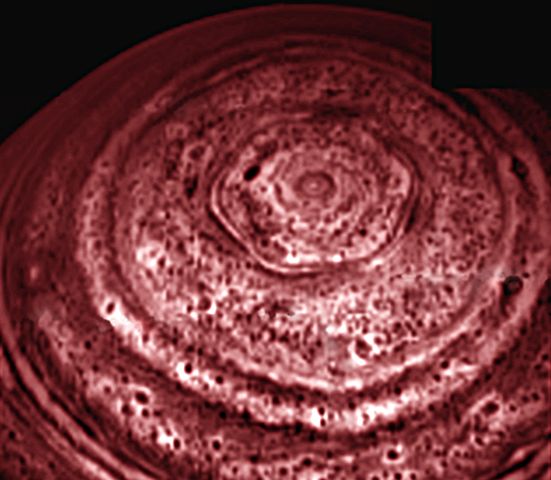|
[[en:Image:PIA09185.jpg|thumb|right|200px|Sister image: en::Image:PIA09185.jpg]] en:NASA image 172325main_pia09188-516.jpg Caption
See for full caption and high resolution version of this image. "A bizarre six-sided feature encircling the north pole of en:Saturn near 78 degrees north latitude has been spied by the visual and infrared mapping spectrometer on NASA's Cassini spacecraft. This image is one of the first clear images ever taken of the north polar region as seen from a unique polar perspective. Originally discovered and last observed by a spacecraft during NASA's Voyager flybys of the early 1980's, the new views of this polar en:hexagon taken in late 2006 prove that this is an unusually long-lived feature on Saturn. This image is the first to capture the entire feature and north polar region in one shot, and is also the first polar view using Saturn's thermal glow at 5 en:microns (seven times the wavelength visible to the en:human eye) as the light source. This allows the pole to be revealed during the nighttime conditions presently underway during north polar winter. Previous images from Voyager and from ground-based en:telescopes suffered from poor viewing perspectives, which placed the feature and the north pole at the extreme northern limb (edge) of the planet. To see the deep atmosphere at night, the en:infrared instrument images the thermal glow radiating from Saturn's depths. Clouds at depths about 75 kilometers (47 miles) lower than the clouds seen at visible wavelengths block this light, appearing dark in silhouette. To show clouds as features that are bright or white rather than dark, the original image has been contrast reversed to produce the image shown here. The nested set of alternating white and dark hexagons indicates that the hexagonal complex extends deep into the atmosphere, at least down to the 3-Earth-atmosphere pressure level, some 75 kilometers (47 miles) underneath the clouds seen by Voyager. Multiple images acquired over a 12-day period between en:October 30 and en:November 11, en:2006, show that the feature is nearly stationary, and likely is an unusually strong pole-encircling planetary wave that extends deep into the atmosphere. This image was acquired on en:October 29, 2006, from an average distance of 902,000 kilometers (560,400 miles) above the cloud tops of Saturn. The Cassini-Huygens mission is a cooperative project of NASA, the en:European Space Agency and the en:Italian Space Agency. The en:Jet Propulsion Laboratory, a division of the en:California Institute of Technology in en:Pasadena, manages the mission for NASA's Science Mission Directorate, Washington, D.C. The Cassini orbiter was designed, developed and assembled at JPL. The Visual and Infrared Mapping Spectrometer team is based at the en:University of Arizona, where this image was produced. For more information about the Cassini-Huygens mission visit saturn.jpl.nasa.gov. The visual and infrared mapping spectrometer team homepage is at wwwvims.lpl.arizona.edu. Credit: NASA/JPL/University of Arizona" Peter Ellis 01:05, 28 March 2007 (UTC) en:Category:Saturn |


